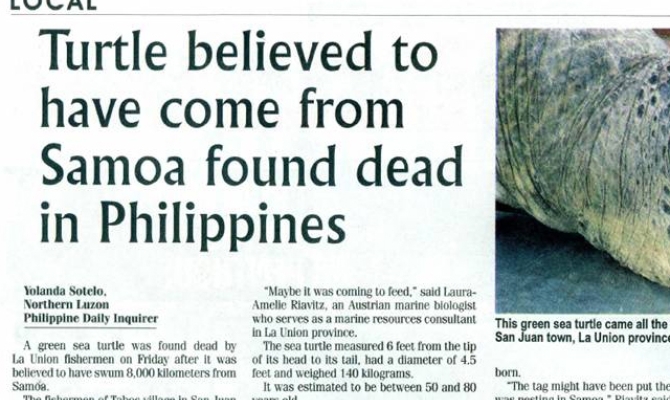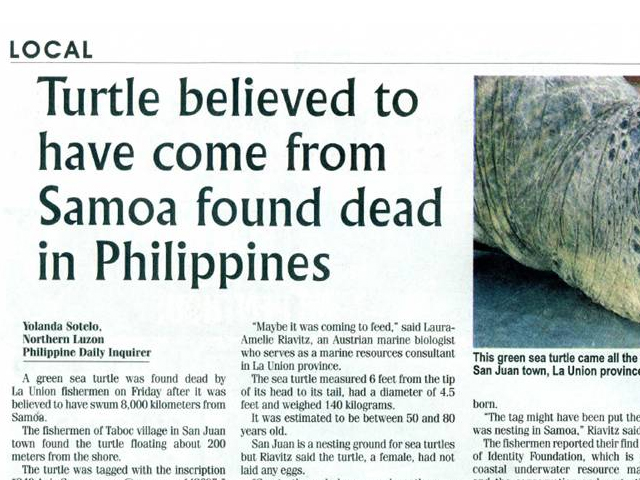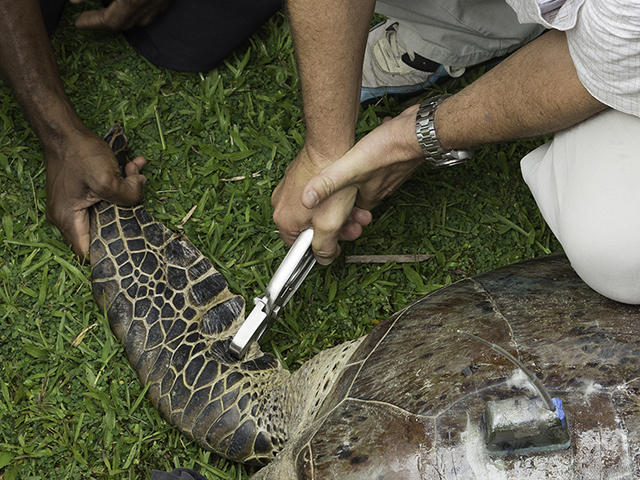
Biodiversity Conservation
New light has been shed on the origins of a green turtle, believed to have come from Samoa, which was found dead by local fishermen in the Philippines. Speculation that the turtle had come from Samoa stemmed from the fact that the turtle had been clipped with a tag which was inscribed with the contact details for the Secretariat of the Pacific Regional Environment Programme (SPREP) in Apia.

SPREP's Turtle Database Officer, Ms. Catherine Siota, has today confirmed that this particular green turtle had not been tagged in Samoa, but in the Federated States of Micronesia (FSM).
"The female green turtle was initially tagged while nesting in Gielop Island, Ulithi Atoll, Yap state in the Federated States of Micronesia on May 6, 2011 by Ulithi Marine Turtle Project Officers."
"While SPREP was not involved in the tagging process, we distributed the tags as part of our regional turtle tagging programme and the information collected is stored in our regional Turtle Research and Monitoring Database System (TREDS). The SPREP contact information at the back of each tag is for people to be able to report the tag recoveries back to us. We give out a reward of a tag recovery t-shirt to people who report turtle tag details."
The Philippines may seem like a very long distance from FSM. But for a green turtle, travelling this kind of distance is not unusual. Ms. Siota explains, "One of the reasons why green turtles are endangered is that they are highly migratory and frequently cross international boundaries. This makes it difficult to protect them through uniform legislation."
"An important part of our work is to spread the message that marine turtles are shared resources, so everyone is responsible to help manage and conserve them."

Other green turtles tagged on Gielop Island have been reported in the Philippines previously, as well as in Papua New Guinea, Indonesia, Palau and Japan. This shows us that green turtles that nest at that location have several foraging grounds in different countries/territories. These are sites where they migrate to feed and rest until they can store enough fat reserve in their bodies to be able to take that long journey back to Gielop Island for nesting, after about two to eight years.
Green turtles' status under the IUCN red list of threatened species is endangered, meaning their population is facing a high risk of extinction. There are many threats to survival of green turtles in the region including habitat loss and degradation, hunting (for meat) and pollution. In the case of this particular turtle, cracks on the shell (or carapace) indicate that her death may have been the result of a collision with a boat.
Ms Siota advises that if people come across a turtle which has a turtle tag, reporting the tag number to SPREP will help us to study turtle migration patterns and to estimate how many turtles are currently living in the area. Once this information is collected it is then used to plan how to best monitor and manage the conservation of marine turtles in the Pacific region.
For more information about SPREP's turtle tagging program visit http://www.sprep.org/marine-turtles/turtle-tagging

SPREP's Turtle Database Officer, Ms. Catherine Siota, has today confirmed that this particular green turtle had not been tagged in Samoa, but in the Federated States of Micronesia (FSM).
"The female green turtle was initially tagged while nesting in Gielop Island, Ulithi Atoll, Yap state in the Federated States of Micronesia on May 6, 2011 by Ulithi Marine Turtle Project Officers."
"While SPREP was not involved in the tagging process, we distributed the tags as part of our regional turtle tagging programme and the information collected is stored in our regional Turtle Research and Monitoring Database System (TREDS). The SPREP contact information at the back of each tag is for people to be able to report the tag recoveries back to us. We give out a reward of a tag recovery t-shirt to people who report turtle tag details."
The Philippines may seem like a very long distance from FSM. But for a green turtle, travelling this kind of distance is not unusual. Ms. Siota explains, "One of the reasons why green turtles are endangered is that they are highly migratory and frequently cross international boundaries. This makes it difficult to protect them through uniform legislation."
"An important part of our work is to spread the message that marine turtles are shared resources, so everyone is responsible to help manage and conserve them."

Other green turtles tagged on Gielop Island have been reported in the Philippines previously, as well as in Papua New Guinea, Indonesia, Palau and Japan. This shows us that green turtles that nest at that location have several foraging grounds in different countries/territories. These are sites where they migrate to feed and rest until they can store enough fat reserve in their bodies to be able to take that long journey back to Gielop Island for nesting, after about two to eight years.
Green turtles' status under the IUCN red list of threatened species is endangered, meaning their population is facing a high risk of extinction. There are many threats to survival of green turtles in the region including habitat loss and degradation, hunting (for meat) and pollution. In the case of this particular turtle, cracks on the shell (or carapace) indicate that her death may have been the result of a collision with a boat.
Ms Siota advises that if people come across a turtle which has a turtle tag, reporting the tag number to SPREP will help us to study turtle migration patterns and to estimate how many turtles are currently living in the area. Once this information is collected it is then used to plan how to best monitor and manage the conservation of marine turtles in the Pacific region.
For more information about SPREP's turtle tagging program visit http://www.sprep.org/marine-turtles/turtle-tagging